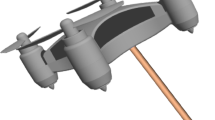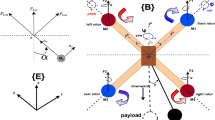Abstract
The quadrotor suspended payload systems have difficulties to achieve precise positioning of the quadrotor UAV and suppression of the load swing angle at the same time because of their characteristics, such as underactuated, strongly coupling, nonlinear and so on. An enhanced coupling anti-swing controller is proposed to solve these problems. With analysis on the relationship between the displacement of quadrotor UAV and the payload swing angle, the three-dimensional dynamic variable rope length model of a quadrotor UAV based on Euler–Lagrange equation is built. An anti-swing method based on energy coupling is designed for this system to realize positioning and eliminate the problem of residual load swing. A new auxiliary signal function is constructed to enhance the coupling relationship between UAV position and load position. The control strategy of three-dimensional quadrotor UAV is designed based on the signal function by the Lyapunov stability theory. The stability of this system is proved by the Lyapunov method and the Barbalat's Lemma. With the experiment, the proposed method is compared with different control methods, the results show that the proposed method can realize the accurate positioning of the quadrotor UAV more quickly and restrain the load swing more effectively. It has strong robustness and stability after the system is added to the disturbance.











Similar content being viewed by others
Data availability
Data cannot be made available for reasons disclosed in the data availability statement.
Code availability
Not applicable.
References
Bhat, A., Bhanuranjan, S. B., Narayan, K. G. L., et al. (2023). Survey on object detection, face tracking, digital map** and lane following for remotely piloted aerial systems (RPAS). International Journal of Human Computations & Intelligence, 2(2), 94–105.
Kwak, J., Lee, S., Baek, J., et al. (2022). Autonomous UAV target tracking and safe landing on a leveling mobile platform. International Journal of Precision Engineering and Manufacturing, 23(2), 305–317.
Rigatos, G. G. (2021). A nonlinear optimal control approach for the UAV and suspended payload system. Cybernetics and Physics, 10(11), 27–39.
Yi, K., Liang, X., et al. (2019). Active-model-based control for the quadrotor carrying a changed slung load. Electronics, 8(4), 461–488.
Zeng, J., Kotaru, P., Mueller, M. W., et al. (2020). Differential flatness based path planning with direct collocation on hybrid modes for a quadrotor with a cable-suspended payload. IEEE Robotics and Automation Letters, 5(2), 3074–3081.
Chandra, A., & Lal, P. (2022). Higher order sliding mode controller for a quadrotor UAV with a suspended load. IFAC-PapersOnLine, 55(1), 610–615.
**an, B., Wang, S., & Yang, S. (2020). An online trajectory planning approach for a quadrotor UAV with a slung payload. IEEE Transactions on Industrial Electronics, 67(8), 6669–6678.
Hashemi, D., & Heidari, H. (2020). Trajectory planning of quadrotor UAV with maximum payload and minimum oscillation of suspended load using optimal control. Journal of Intelligent & Robotic Systems, 100(3–4), 1369–1381.
Cruz, P. J., & Fierro, R. (2017). Cable-suspended load lifting by a quadrotor UAV: Hybrid model, trajectory generation, and control. Autonomous Robots, 41(8), 1629–1643.
Wang, J., Yuan, X., & Zhu, B. (2022). Geometric control for trajectory-tracking of a quadrotor UAV with suspended load. IET Control Theory & Applications, 12, 16.
Yu, G., Cabecinhas, D., Cunha, R., et al. (2019). Nonlinear backstep** control of a quadrotor-slung load system. IEEE/ASME Transactions on Mechatronics, 24(5), 2304–2315.
Qian, L., & Liu, H. H. T. (2019). Path-following control of a quadrotor UAV with a cable-suspended payload under wind disturbances. IEEE Transactions on Industrial Electronics, 67(3), 2021–2029.
Barikbin, B., & Fakharian, A. (2019). Trajectory tracking for quadrotor UAV transporting cable-suspended payload in wind presence. Transactions of the Institute of Measurement and Control, 41(5), 1243–1255.
Lv, Z. Y., Wu, Y., & Rui, W. (2020). Nonlinear motion control for a quadrotor transporting a cable-suspended payload. IEEE Transactions on Vehicular Technology, 69(8), 8192–8206.
Kang, B., Miao, Y., Liu, F., et al. (2021). A second-order sliding mode controller of quad-rotor UAV based on PID sliding mode surface with unbalanced load. Journal of Systems Science and Complexity, 34(3), 520–536.
Meissen, C., Klausen, K., Arcak, M., et al. (2017). Passivity-based formation control for UAVs with a suspended load. Ifac Papersonline, 50(1), 13150–13155.
Bacelar, T., Madeiras, J., Melicio, R., et al. (2020). On-board implementation and experimental validation of collaborative transportation of loads with multiple UAVs. Aerospace Science and Technology, 107(12), 106284.
Li, X., Zhang, J., & Han, J. (2021). Trajectory planning of load transportation with multi-quadrotors based on reinforcement learning algorithm. Aerospace Science and Technology, 116(9), 106887.
Lee, E. S., & Yoon, H. S. (2022). Development of a rod gripper for drones using flexible fingers and bistable structures. International Journal of Precision Engineering and Manufacturing, 23(9), 1325–1335.
Goodarzi, F. A., & Lee, T. (2015). Dynamics and control of quadrotor UAVs transporting a rigid body connected via flexible cables//2015 american control conference (ACC). IEEE, pp. 4677–4682.
Das, H. (2018). Dynamic inversion control of quadrotor with a suspended load. In IFAC Conference on Advances in Control and Optimization of Dynamical Systems.
Dai, S., Lee, T., & Bernstein, D. S. (2014). Adaptive control of a quadrotor uav transporting a cable-suspended load with unknown mass. In Proceedings of 45th IEEE Conference on Decision and Control.
Yang, S., & **an, B. (2019). Energy-based nonlinear adaptive control design for the quadrotor UAV system with a suspended payload. IEEE Transactions on Industrial Electronics, 67(3), 2054–2064.
Sierra-García, J. E., & Santos, M. (2021). Intelligent control of an UAV with a cable-su5spended load using a neural network estimator. Expert Systems with Applications, 183, 115380.
Joo, M., Yoon, J., Junejo, A. R., et al. (2022). Optimization: Drone-operated metal detection based on machine learning and PID controller. International Journal of Precision Engineering and Manufacturing, 23(3), 503–515.
Bingöl, Ö., & Güzey, H. M. (2022). Finite-time neuro-sliding-mode controller design for quadrotor UAVs carrying suspended payload. Drones, 6(10), 311–325.
Wu, Z., **a, Y., & **e, X. (2012). Stochastic Barbalat’s lemma and its applications. IEEE Transactions on Automatic Control, 58(7), 1548–1554.
Sun, N., & Fang, Y. (2014). An efficient online trajectory generating method for underactuated crane systems. International Journal of Robust & Nonlinear Control, 24(11), 1653–1663.
Jaafar, H. I., & Mohamed, Z. (2017). PSO-tuned PID controller for a nonlinear double-pendulum crane system. Communications in Computer and Information Science, 752(6), 203–215.
Sun, N., Fang, Y., Chen, H., & He, B. (2014). Adaptive nonlinear crane control with load hoisting/lowering and unknown parameters: Design and experiments. IEEE/ASME Transactions on Mechatronics, 20(5), 2107–2119.
Funding
This work is supported by Natural Science Foundation of Henan Province (242300421241) and CSC Scholarship.
Author information
Authors and Affiliations
Corresponding author
Ethics declarations
Ethics approval and consent to participate
Informed consent was obtained from all individual participants included in the study.
Consent for publication
The participant has consented to the submis sion of the case report to the journal.
Competing interests
The authors have no relevant financial or non-financial interests that are relevant to the content of this article.
Additional information
Publisher's Note
Springer Nature remains neutral with regard to jurisdictional claims in published maps and institutional affiliations.
Rights and permissions
Springer Nature or its licensor (e.g. a society or other partner) holds exclusive rights to this article under a publishing agreement with the author(s) or other rightsholder(s); author self-archiving of the accepted manuscript version of this article is solely governed by the terms of such publishing agreement and applicable law.
About this article
Cite this article
Zhang, Y., Fan, B., Sun, L. et al. An Enhanced Energy Coupling-Based Control Method for Quadrotor UAV Suspended Payload with Variable Rope Length. Int. J. Precis. Eng. Manuf. (2024). https://doi.org/10.1007/s12541-024-01052-1
Received:
Revised:
Accepted:
Published:
DOI: https://doi.org/10.1007/s12541-024-01052-1




